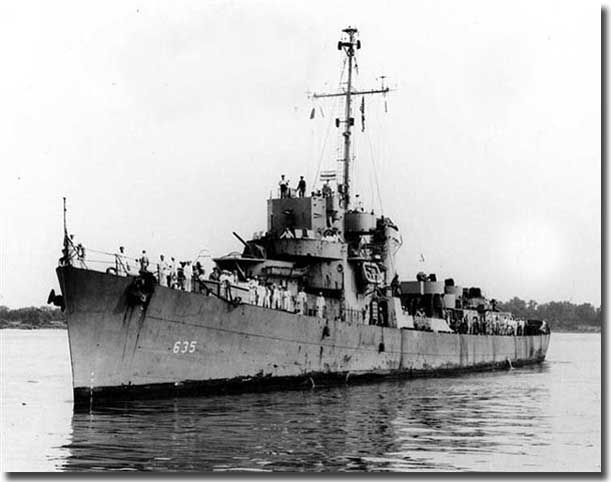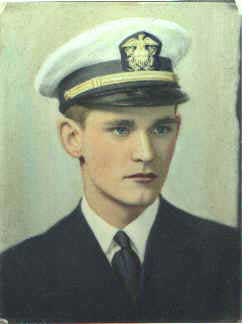Introduction.
Over a 12 day period in the last two weeks of May in 1944, the Destroyer Escort USS England accounted for 6 Japanese Submarines. I-16, RO-106, RO-104, RO- 116, RO-108 and RO-105 were all sunk. This was a record number of kills, unsurpassed in WW2. These spectacular results drew a Presidential Citation for this ship.

Destroyer Escort USS England
Naming of the ship.
USS England was named after Ensign John Charles England, who, at the time of the Japanese attack on the US Fleet at Pearl Harbor on the 7th. of December 1941, was serving in the Battleship BB-37, USS Oklahoma. He had survived the initial attack being on deck, and on three occasions he went below to the radio room, each time leading a man to safety. He left, to return below decks a fourth time, never to be seen again. 20 Officers and 395 Enlisted men died in Oklahoma. Ensign England's mother Thelma launched USS England in San Francisco on the 26th. of September in 1943.

Ensign John Charles England after whom USS England was named.
Read more about Ensign England.
USS England leaves Purvis Bay.
On the 18th. of May 1944, Lieutenant Commander Walton B. Pendleton conned his command, the Destroyer Escort USS England out of Purvis Bay off Florida Island in the Pacific, in company with USS Raby, and USS George, they were on a sweep looking for Japanese submarines.
The first action.
It was on the 19th. of May, an Allied aircraft sighted I-16 running on the surface some 140 miles North East of Cape Alexander in the Solomon Islands, it reported this find and the hunt was on. At 1341 ( 1.41 PM ) Pendleton started the 1st. of 5 attacks using his ahead throwing weapon, Hedge Hog. Hits registered with both the 2nd. and 5th. attacks, and explosions were shown at a depth of 500 feet, it took 20 minutes for debris from a submarine to slowly rise to the surface. Such items as shreds of cork, deckplanking, pieces of cabinets, a rubber container holding a bag of rice, and an hour later, an oil slick was evident on the ocean surface. The next day this slick had spread to be 3 by 6 miles in size, this then was evidence for a definite kill.
Second attack.
On the 22nd. of May 1944, George made radar contact at 17,000 yards, England confirmed it, now George reported a sonar contact at 1,7000 yards, and quickly attacked with her Hedge Hog, without result.
England regained contact at 2,800 yards and then made two Hedge Hog runs at about 0433 ( 4.33 AM ) and 0444 ( 4.44 AM ) in another 18.2 seconds after firing the second load of HH projectiles there were 3 or more explosions, then, after 7.5 minutes, a violent under water explosion was heard, after which, no further sonar contact was regained. At 0630 ( 6.30 AM ) there was a strong smell of oil in the air, and it was rightly assumed another kill had been achieved.
Third attack.
On the night of the 22nd./23rd. of May, all three escort destroyers were searching for a submarine that reportedly had crash dived. At 0600 ( 6 AM ) Raby reported she had a radar contact at 11,000 yards, it proved to be a surfaced submarine that dived when she had closed to 600 yards range, and this ship made four separate Hedge Hog attacks, without any evidence of gaining hits on the target.
George regained contact at 0704 ( 7. 04 AM ) and she also let fly with four HH attacks, still no results. She maintained contact on the enemy submarine, whilst England made a very deliberate Hedge Hog attack at 0823 ( 8. 23 AM ) to be followed up with a second attack immediately. The second run with the HH brought 8 to 10 hits after 14.5 seconds from firing the 24 ahead thrown projectiles. A violent under water explosion was heard in three more minutes, by 1045 ( 10.45 AM ) oil and a lot of debris drifted up to the surface, and samples of both were collected to confirm a third kill.

USS England damaged by a Kamikaze aircraft off Okinawa 9th of May 1945.
Aircraft Symbols for the three Japanese aircraft shot down by her crew,
plus a Submarine symbol with 6 Marks underneath,
in an amazing 12 days this ship was responsible for sinking six Japanese Submarines,
this feat must enter this Destroyer Escort, her Captain and crew into the record books
for disposing of the most enemy submarines.
The Pennant painted here denotes the ship's Presidential Citation.
Fourth attack.
The three escort destroyers were all having a field day against the Japanese Submarines, at 0122 ( 1.22 AM ) on the 24th. of May, all three ships were spread in a searching line distance 8 miles apart. George picked up a radar contact at 1,250 yards at 0150 ( 1.50 AM ) and blasted off her first Hedge Hog attack 24 minutes later, after 7.2 seconds two hits were made, and rumbling noises were heard. At 0702 ( 7.02 AM ) a ship's boat recovered deck planking, and observed a number of oil patches on the surface.
The Group Commander was not satisfied a kill had been made, and at 1120 ( 11.20 AM ) a creeping attack was made, with England maintaining contact, whilst her consort crept up to be in a position to fire her HH. The target turned towards England, and George unleashed a 32 charge pattern, England reinforced this depth charge attack by now dropping a 13 charge pattern. It must have been HELL inside the Japanese submarine as all these depth charges exploded all around it.
That afternoon, both oil and debris had floated to the surface to spread over several square miles of the Pacific Ocean. A certain death for the 4th. Japanese submarine.
Fifth attack.
Now the 25th. of May, Raby had a radar contact at a range of 15,000 yards at 2312 (11.12 PM)this group seemed to like working at night, perhaps the Japanese submarines running on the surface at night kept a less vigilant watch, believing they would be safe. On the other hand, the American Navy had most efficient surface radar equipment, and to pick up the low silhouette of a surfaced submarine at 7.5 miles was quite and achievement.
Ruby had closed to 4,100 yards before this submarine dived. England's sonar picked up the target at 1,700 yards, and at 2323 ( 11.23 PM ) squired off her Hedge Hogg projectiles, to hear 4/6 explosions 11 seconds after firing them. No further sonar contact could be made, and in daylight, debris was recovered to confirm the death of the fifth Japanese boat.
Sixth attack.
No the 30th. of May, Hazelwood had picked up a radar contact at a range of 7,000 yards, at 4,000 yards it disappeared, probably an indication that this submarine had submerged. Two depth charges attacks were made on where it was believed the submarine had dived, but with any tangible result. At 0220 ( 2.20 AM ) George and Raby were sent to assist in the hunt and Hazelwood was released.
At 0528 ( 5.28 AM ) Raby attacked a sonar contact some 7 miles south of George and two Hedge Hog patterns were despatched. George fired a third HH pattern, and heard three explosions. At 0835 ( 8:35 AM ) and aircraft closed George to direct her to an oil slick some half a mile long by a quarter mile wide, it was about 4 miles north of the first position attacked with depth charges. At 1337 ( 1.37 PM ) George fired of a HH pattern to hear an undetermined number of explosions. Contact was maintained with this submarine, and at 0150 ( 1.50 AM ) George obtained a depth reading of 35/41 fathoms, for this submarine.
This firm contact was tackled during the dark hours with a Hedge Hog run, and 7/8 violent explosions were registered. At 0302 ( 3.02 AM ) a large submarine was sighted between the two destroyer escorts who were 4,000 yards apart, it then dived, and George maintained sonar contact till sunrise.
At 0550 ( 5.50 AM ) England and Spangler joined the hunt, with England using her HH to attack almost an hour later, Raby, Spangler, and England, all made separate attacks, but it was the attack by England that drew results, 9.2 seconds after her projectiles were sent off 6/10 explosions were heard. In a further 5 minutes 43 seconds, a huge under water explosion erupted. Debris, and an oil sample were picked up, including painted wood, and deck planking with Japanese writing on it.
Again we have positive evidence of the destruction of yet one more Japanese submarine, to bring the total to an amazing figure of six kills, all credited to one ship, USS England.
Depth Charge attacks versus attacks made with the Hedge Hog ahead throwing weapon.
Although both Depth Charges, and the Hedge Hog ahead throwing weapon were employed in these attacks against the six Japanese submarines, it was without exception, the Hedge Hog weapon that proved to be the killer. The basic reason for its development, was the fact that it allowed the attacking ship to remain in contact with its target right up to the time of firing off its 24 projectiles, and here we find that reason fully justified. England achieved kill after kill!
With a Depth Charge attack, when the hunter ran over the top of the hunted, the ASDIC equipment in its dome ( usually sited in the ship's keel, generally located below the level of the bridge ) lost contact with the enemy submarine. The attacker still had to steam the distance between the ASDIC dome, and the stern where the Depth Charges are housed, before these weapons could be fired. In that dead time, the submarine under attack, no longer pinned by the ASDIC beam, can, and usually does, takes violent avoiding action. Depth Charges detonate anyway, Hedge Hog only detonate on achieving a hit.
Depth Charges are fired preset to a particular depth, and, no matter where the quarry may be located, when reaching that set depth, they explode. On the other hand, with the Hedge Hog's 24 projectiles, they only explode on impact with their target. Thus, any explosion heard after firing a HH pattern will indicate a hit or hits upon the enemy
submarine.
The Hedge Hog was lethal in all six attacks, and six kills were all credited to USS England.
AN UNSURPASSED RECORD IN ANY OPERATIONAL AREA DURING WW2.
|
Presidential Unit
Citation
The President of the United States has presented the Presidential Unit
Citation to the USS ENGLAND for service as set forth in the following
citation:
"For outstanding performance in combat against enemy forces from
May 19 to 31, 1944. Utilizing to the full all available weapons and
equipment the USS ENGLAND skillfully coordinated her attacks with other
vessels and with cooperating aircraft, striking boldly and with
exceptional precision at the enemy. In a sustained series of attacks,
she destroyed six hostile ships within twelve days effecting this
devastating blow to enemy operations during a particularly crucial
period and disrupting attempts by the enemy to supply or evacuate key
units. By this heavy loss to the enemy the ENGLAND contributed
substantially to unmolested advance of the United States Fleet pointing
toward subsequent seizure and occupation by our forces. A gallant and
daring fighter, superbly ready ready combat, the ENGLAND has achieved an
outstanding record of success, reflecting the highest credit upon her
gallant officers and men and the United States Naval Service."
|

USS Oklahoma
I am indebted to this site: USS England DE-635 for both information and photographs.
Mac.




